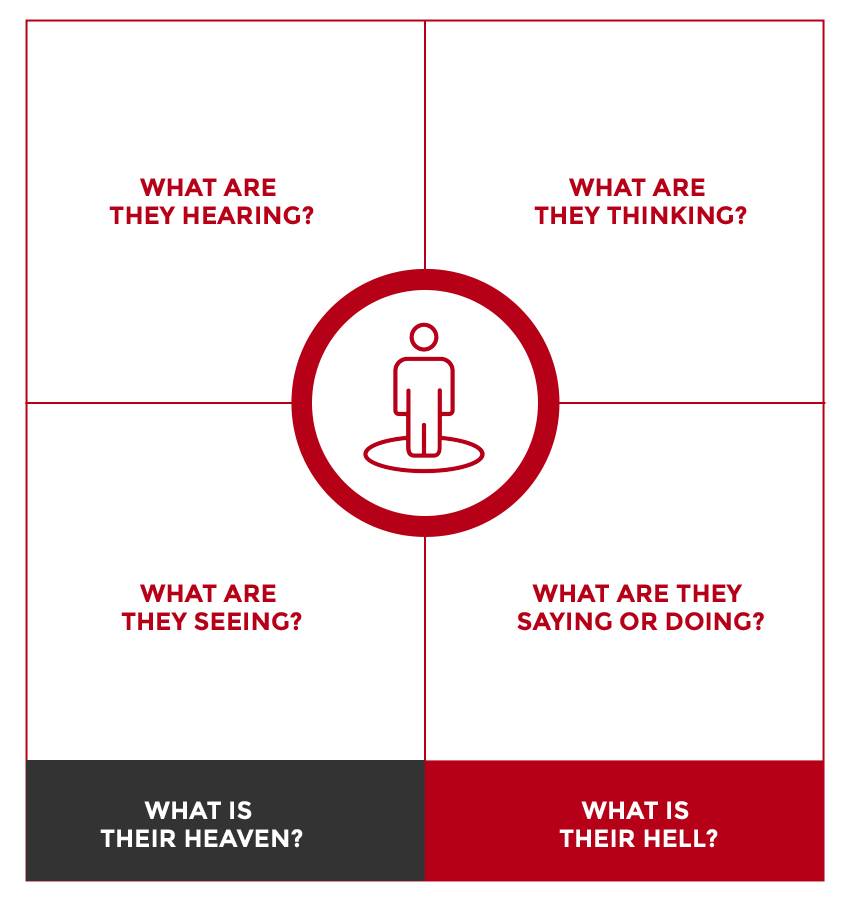Table of Contents
It is easy to forget who your target audience is when you’ve been marketing your particular product or service for a long time. You get caught up with what you want to sell them and when you want to sell to them – ignoring their pain points, what problems they need to solve, when they are comfortable to take the next step in the buyer’s journey, and more. You simply forget why you are doing what you do – your customer.
So how do you keep your ideal customer at the center of everything you do? Empathy maps.
Simply put, empathy mapping helps to keep your customer and their wants and needs at the center of your marketing strategy.
What are Empathy Maps?
An empathy map is a tool that represents a particular customer segment or buyer’s persona. It is a document, or sometimes a visual, that lays out what you need to know about your customer to effectively market to them.
The empathy mapping process helps your team gather and organize customer information in a single place. The process also helps to identify potential knowledge gaps. If your team struggles with completing the empathy map, it is a sign that more research is needed.
What Should Empathy Maps Include?
Since the purpose of the empathy map is to paint a picture of your customer, there are a few elements that every map includes. It is best to have an empathy mapping session with several team members to ensure you paint a complete picture of your customer, how they are and not just how you want to see them.
What is their current situation and environment?
It is important to recognize what your customer’s situation is and daily experiences. Who do they spend their time with at work or at home? What are they thinking – both positive and negative? What are they worrying about? What are they hearing from family and friends, co-workers and customers? What are they saying and doing on a daily basis? Where are they getting their information from? What are their goals?
Focus on the aspects that matter and do not get distracted by anything that is not relevant to your ultimate goal.

What is their heaven and hell?
If your customer could have the perfect situation what would it look like? What are their biggest fears? What would make their situation worse? What are their biggest pain points?
How to Use Empathy Maps
You’ve created an empathy map, now what?
Once the empathy map is created, it is time to start applying those collective insights to your marketing efforts. You should revisit the empathy map before developing any website copy, blog posts, paid ads, social posts, emails, etc. Rereading the empathy map will keep your customer in the center of everything you do.
You’ve created an empathy map, now what?
An organic grocery store created an empathy map of their core audiences. During the process it became clear that the women who shopped in the store were often working mothers with young children. These women hear about additives in conventional food, are worried about purchasing healthy food for their children, and are often too busy to shop for everything they need. With this in mind, the grocery store marketing team created a series of social ads that promoted its organic groceries and included simple weeknight recipes. The store also promoted its curb-side pick-up and grocery delivery options to save time. Had the empathy map not been created, the grocery store team could have easily been advertising high-end ingredients used in complicated recipes and offering only traditional, in-store purchases.
Tips to Get Your Team Mapping
- Identify who you want to create an empathy map for and why you want to develop the map before starting the planning process. It is recommended that you create one empathy map per persona.
- Don’t develop an empathy map alone. Including a team will help to gather more information on the customer and encourage buy-in. Some teams use a shared Google Doc and others workshop the planning process with sticky notes on a wall.
- Be sure to collect any research your team may have before you begin the mapping process and plan to conduct any research during and after to help fill in any missing pieces of information.
- Customers and industries change so don’t be afraid to update your empathy map. It is a sign that your team is dedicated at keeping the customer at the center of everything you do and are flexible enough to adapt.
While empathy maps were first created for the design process and not marketing, the same theory applies. Keep your persona (or end-user) at the core of everything you do. Speak to them and not to yourself.
